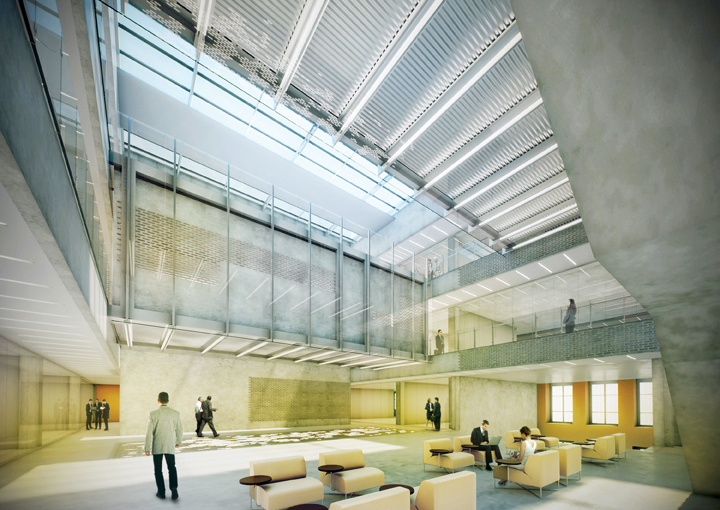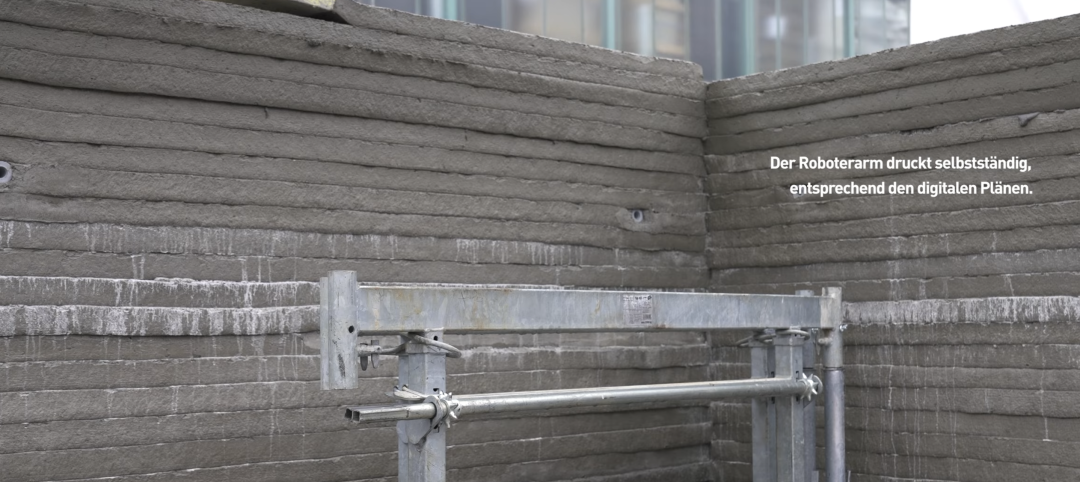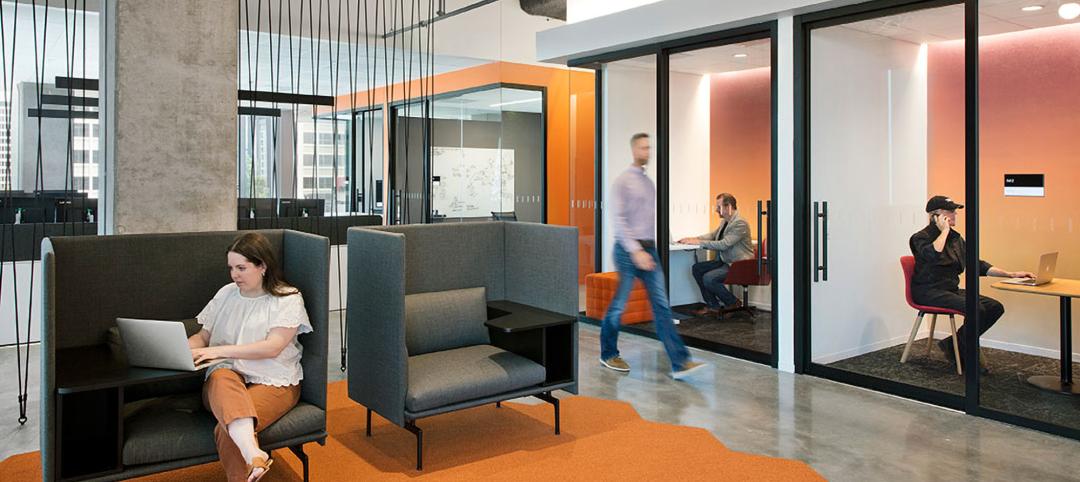In February, we opened our 2012 series on design and construction trends in university buildings with a report on “fusion facilities”. We continue the discussion with four more trends that are shaping collegiate projects:
- New concepts of classroom design
- Increasing use of flexible space concepts
- More common areas for collaboration
- Repurposing of library space
Behind these trends are several dramatic forces that are cutting right to the heart of the university’s mission:
- The growing use of project-based teaching
- The pressure to hold costs down as rising tuition and fees outpace inflation
- A movement to promote cross-disciplinary collaboration
- New technologies that are changing pedagogy and how students and faculty interact
1. NEW TAKE ON THE COLLEGE CLASSROOM
Current pedagogical methods at the college level emphasize problem-based learning and collaboration among students over the traditional lecture format. “Experiential learning is at the forefront of just about every discipline,” says Jeff Ziebarth, AIA, LEED AP, a principal in the Minneapolis office of Perkins+Will. “Students are becoming the instructors, and instructors are becoming facilitators.” Working on group projects is believed to promote better retention of knowledge than the traditional lecture model, researchers are finding. So, classrooms must change to meet these new demands.
The Technology Enabled Active Learning (TEAL) classroom in MIT’s Stata Center for Computer, Information and Intelligence Sciences contains 13 round tables, with seating for nine students per table, and three laptop computers per table to accommodate teams of three students. Instructors sit at a workstation in the center of the room. A typical class includes hands-on experimentation supported by interactive digital media.
New and renovated classrooms at many institutions include easily movable furniture and media-rich presentation technology. Missing from this picture: a front-of-the-room podium, says Brad Lukanic, AIA, LEED AP, a principal with Cannon Design, New York. “Every surface of the room has media on it,” he says. “There could be projectors on all four walls.” Packed with electronics, these rooms may require an upgraded electrical system on rehabs of older buildings.
Students can project their work onto a single screen for their own group or onto multiple screens for the whole class to view. “This design takes more square footage than the traditional classroom,” 25-40 sf/person for multimedia, vs. 17-18 sf/person for traditional, Lukanic notes. That makes it more critical for administrators to maximize the utilization rates of updated classrooms. In many cases, multiple departments must share these spaces, which goes against the grain of many institutions that are accustomed to having dedicated buildings for each discipline.
[pagebreak]
2. FLEXIBILITY: THE KEY TO NEW DESIGNS
At Duke University, Durham, N.C., the Link Teaching and Learning Center—a prototype area for testing new teaching methods—is a new space shared by many departments. Housed in the ground floor of the university’s central library, the technology-rich space is highly flexible to accommodate classes and study groups of varying sizes. A test bed for new classroom design, Duke has undertaken a detailed assessment of the Link for lessons on how other classrooms could be redesigned.
The flexibility to reconfigure space for different uses is built into many collegiate projects today. The Link’s classrooms feature an above-ceiling strut system with power and data connections. Speakers, cameras, microphones, and monitors can be easily installed and moved as needed. An IT support group is housed within the Link for assistance with the technology. Some classrooms have their own connected breakout rooms for group work. A large, open lobby area and wide corridors offer additional space for working groups to use. Large whiteboards on wheels and movable furniture allow groups to create their own nooks.
Furniture in Link classrooms is easily reconfigurable. Each classroom has slides posted on the wall to demonstrate multiple configurations; before class, students rearrange the furniture from these templates. “Faculty don’t want to be responsible for setting up furniture,” says Thomas D. Kearns, AIA, LEED AP, a principal with Shepley Bulfinch, Boston.
The University of North Carolina, Charlotte, recently broke ground on a small-business incubator, the PORTAL, that is designed to take flexibility even further. Most plumbing, electrical, communication, and HVAC systems have been positioned in the ceilings so that the walls can be easily moved or removed. “We looked at using demountable partitions, but the costs didn’t line up,” says Ryan J. Mullenix, AIA, a principal in NBBJ’s Columbus, Ohio, office. The typical small business stays in an incubator for about 39 months, he says, so reconfigurations would not be necessary often enough to justify the cost of demountable partitions. The building will be constructed so that additional wings could be connected on the ground floor at several locations in the future.
Increasingly, universities want flexible spaces that can have multiple uses over their lifetimes. “We’re working with clients to create more modular spaces,” Ziebarth says. For example, by using raised access flooring with displacement ventilation, a space can be inexpensively converted from a 40- to 50-seat classroom to five faculty offices by using movable, interchangeable wall systems.
[pagebreak]
3. PROMOTING COLLABORATION
Fostering collaboration is a common theme for most collegiate projects. Huddle space for students, faculty groups, and researchers is being set aside to promote interaction. Co-locating different disciplines within the same building is an increasingly common tactic, all in the belief that more effective learning, higher-quality research, and greater levels of innovation result when academics from different backgrounds and disciplines work in close proximity.
This concept is being implemented at UNCC’s Portal building which, to promote interaction among incubator firms, will have some offices with windows facing the interior of the building. Shared conference rooms and kitchenettes will be centrally located within bridges connecting two wings. These areas will be flooded with natural light to draw entrepreneurs together for impromptu conversations during the day; at night, they’ll be able to see others burning the midnight oil, possibly leading to breakthrough business opportunities, says Mullenix.
[pagebreak]
4. RETHINKING THE LIBRARY
As print rapidly migrates to digital, the mission of the campus library is—well, in turmoil. Not all books will go the way of the Encyclopedia Britannica, but that doesn’t mean that they all have to be on library shelves. Many universities are relocating at least part of their print collections to remote storage facilities—some using robotic automated retrieval systems—so that precious library space can be repurposed. Scholars can reserve them on their laptops for later pickup.
At some community colleges and primarily commuter colleges, library space has been converted to lounges and group study rooms, which are lacking at these institutions. “A lot of times, we’ll see students eating lunch in their cars because they don’t have a gathering space,” Mullenix says.
Some collegiate libraries are supplementing the campus computer lab by carving out space for media rooms equipped with large-screen, high-definition monitors and high-end software for video production or other functions that are out of the price range of most students.
“Multi-purpose,” “multi-use,” “reconfigurable”—these are becoming the watchwords behind many university construction projects. As the lines between disciplines blur and teaching methods continue to be refined to meet the demands of today’s online-oriented student, the built environment needs to be able to adjust accordingly. BD+C
Related Stories
Laboratories | May 24, 2024
The Department of Energy breaks ground on the Princeton Plasma Innovation Center
In Princeton, N.J., the U.S. Department of Energy’s Princeton Plasma Physics Laboratory (PPPL) has broken ground on the Princeton Plasma Innovation Center (PPIC), a state-of-the-art office and laboratory building. Designed and constructed by SmithGroup, the $109.7 million facility will provide space for research supporting PPPL’s expanded mission into microelectronics, quantum sensors and devices, and sustainability sciences.
MFPRO+ News | May 24, 2024
Austin, Texas, outlaws windowless bedrooms
Austin, Texas will no longer allow developers to build windowless bedrooms. For at least two decades, the city had permitted developers to build thousands of windowless bedrooms.
Resiliency | May 24, 2024
As temperatures underground rise, so do risks to commercial buildings
Heat created by underground structures is increasing the risk of damage to buildings, recent studies have found. Basements, train tunnels, sewers, and other underground systems are making the ground around them warmer, which causes soil, sand, clay and silt to shift, settle, contract, and expand.
Sports and Recreational Facilities | May 23, 2024
The Cincinnati Open will undergo a campus-wide renovation ahead of the expanded 2025 tournament
One of the longest-running tennis tournaments in the country, the Cincinnati Open will add a 2,000-seat stadium, new courts and player center, and more greenspace to create a park-like atmosphere.
Mass Timber | May 22, 2024
3 mass timber architecture innovations
As mass timber construction evolves from the first decade of projects, we're finding an increasing variety of mass timber solutions. Here are three primary examples.
MFPRO+ News | May 21, 2024
Massachusetts governor launches advocacy group to push for more housing
Massachusetts’ Gov. Maura Healey and Lt. Gov. Kim Driscoll have taken the unusual step of setting up a nonprofit to advocate for pro-housing efforts at the local level. One Commonwealth Inc., will work to provide political and financial support for local housing initiatives, a key pillar of the governor’s agenda.
Building Tech | May 21, 2024
In a world first, load-bearing concrete walls built with a 3D printer
A Germany-based construction engineering company says it has constructed the world’s first load-bearing concrete walls built with a 3D printer. Züblin built a new warehouse from a single 3D print for Strabag Baumaschinentechnik International in Stuttgart, Germany using a Putzmeister 3D printer.
MFPRO+ News | May 21, 2024
Baker Barrios Architects announces new leadership roles for multifamily, healthcare design
Baker Barrios Architects announced two new additions to its leadership: Chris Powers, RA, AIA, NCARB, EDAC, as Associate Principal and Director (Healthcare); and Mark Kluemper, AIA, NCARB, as Associate Principal and Technical Director (Multifamily).
MFPRO+ News | May 20, 2024
Florida condo market roiled by structural safety standards law
A Florida law enacted after the Surfside condo tower collapse is causing turmoil in the condominium market. The law, which requires buildings to meet certain structural safety standards, is forcing condo associations to assess hefty fees to make repairs on older properties. In some cases, the cost per unit runs into six figures.
Office Buildings | May 20, 2024
10 spaces that are no longer optional to create a great workplace
Amenities are no longer optional. The new role of the office is not only a place to get work done, but to provide a mix of work experiences for employees.

















